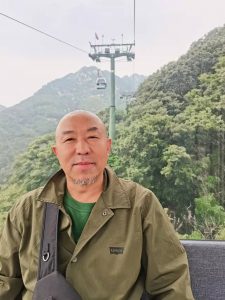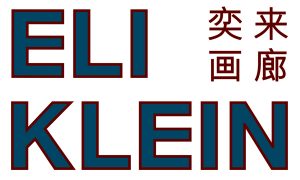Meta.Morf 2022 – Ecophilia / Trøndelag Centre for Contemporary Art / May 19 – July 31
Curator: Zane Cerpina / Co-curator: Espen Gangvik
Planting Grass
Yang Zhichao (CN)
Performance
Time: November 5, 2000
Place: Eastlink Gallery, Shanghai
Process: Two incisions, each 1 centimeter deep by 1 centimeter wide, were made on the performer’s shoulder with no administration of anesthesia. Grass from the Suzhou Creek was then planted in the incisions. The process lasted 45 minutes.
At 10:00 A.M. on November 5, 2000, on the second floor of No.1133 Suzhou Road, Shanghai where Fuck off was taking place, an operation platform measuring 2000×800×780mm was made. An operational scalpel was incised into my left scapula by a surgeon. Without any anesthesia, the surgeon made two incisions, each 1 centimeter deep by 1 centimeter wide. Two freshly picked grasses from Suzhou Creek were then planted into the incisions. The process lasted for 45 minutes.
YANG CHIZHAO
 Yang Zhichao is one of China’s most prominent performance artists. During the historical show Fuck Off at Eastlink Gallery in Shanghai in 2000, Yang Zhichao was widely recognized for his performance work Planting Grass which embraces pain and introduced direct interventions of his own body. Following the exhibition, Yang Zhichao’s other performance pieces became subject of discussions inside and outside of China, establishing Yang as one of the leading figures in Chinese performance art. His exploration and practice has been described as “a peaceful violence towards the body”.
Yang Zhichao is one of China’s most prominent performance artists. During the historical show Fuck Off at Eastlink Gallery in Shanghai in 2000, Yang Zhichao was widely recognized for his performance work Planting Grass which embraces pain and introduced direct interventions of his own body. Following the exhibition, Yang Zhichao’s other performance pieces became subject of discussions inside and outside of China, establishing Yang as one of the leading figures in Chinese performance art. His exploration and practice has been described as “a peaceful violence towards the body”.
Yang Zhichao’s works have been exhibited institutionally worldwide including China Live, Chinese Arts Centre of Manchester, Centre for Contemporary Art, Victoria and Albert Museum, London (2005); Inward Gazes- Documentaries of Chinese Performance Art, Macao Museum of Art, Macao (2005); Art Basel in Hong Kong, Hong Kong (2013); Go East-The Gene Brian Sherman Contemporary A Sina Art Collection, Art Gallery of New South Wales, Sherman Contemporary Art Foundation, New South Wales (2015); Mapping Chinese Art, 1972-2012: Selection from M+ Sigg Collection, Hong Kong (2021) among many others.
Born in 1963 in Yumen City, Gansu Province, China, Yang Zhichao was introduced to art when he was 14 years old. Yang studied painting at the Art Department of Northwest Normal University from 1982 to 1986. During college, he collaborated with colleagues to make contemporary dramas, and hosted discussions and lectures of aesthetic of action. After graduation, Yang was assigned to teach painting at a high school in Lanzhou, Gansu Province. His solid academic training and work experience ensured his success in teaching and painting in the traditional sense. However, Yang had always felt that art should not be limited to the medium of academic painting. In 1987, Yang collaborated with his classmates Xichuan and others to create the performance piece Rolling Canvas. In the following years he united local avant-garde artists in Lanzhou, known as the Lanzhou Group to create several performance pieces that were challenging to public perception at that era. Yang’s time in Lanzhou marked the starting point of his long and lonely journey in performance art. Since then, he began to boldly use his body as a medium for art creation, thus challenging the balance between physical “internal cohesion” and social “tension”.
In 2000, his three renowned works Bask, Brand and Planting Grass, gained his performance art recognition and popularity in China and abroad. In 2002, Yang won the Chinese Contemporary Art Award (CCAA). Since then, he has completed Hide, Chinese Bible, Tao Te Ching, Ear of Wheat, and the Apocalypse series among others. Yang Zhichao has always used his own body and the various conceptual extensions surrounding the body as an experimental ground for his performance art creations. Yang is not only a pioneer of early Chinese performance art, but also one of the few artists in the history of Chinese performance art who had established a unique system of logical narratives.
Yang Zhichao currently lives and works in Beijing.
ELI KLEIN GALLERY
Eli Klein Gallery has an international reputation as one of the foremost galleries specializing in contemporary Chinese art and continues to advance the careers of its represented artists and hundreds of other Chinese artists with whom it has collaborated. The Gallery has been instrumental in the loan of artworks by Chinese artists to over 100 museum exhibitions throughout the world. It has published 40 books/catalogues and organized more than 75 exhibitions of Chinese contemporary art at our prestigious venues in New York City. Eli Klein’s gallery artists have been featured in The Wall Street Journal, The New York Times, Artforum, Newsweek, and ARTnews and have been on CNN and countless other international broadcasts, publications, and online critical reviews.
Located at 398 West Street (between Charles and West 10th) in the trendiest part of the West Village, Eli Klein Gallery is just a few blocks from the new Whitney Museum and the commencement point for the High Line. In a landmarked Federal-style row house that enjoys special cultural, historical and aesthetic value to the City of New York, Eli Klein Gallery occupies 3 levels of the building, boasting 13-foot ceilings on the ground floor.
The Gallery was founded by Eli Klein in 2007. During these formative years, it established a reputation for introducing fresh, contemporary, and often challenging works by rising Chinese talents to the western audiences. Now, as the leading dealer of Chinese contemporary art outside of China, Eli Klein actively promotes cross-cultural awareness and investment at the highest level amongst some of the world’s most influential nations.
Header Graphics: “Planting Grass” by Yang Zhichao. Photo: Courtesy of Eli Klein Gallery.
